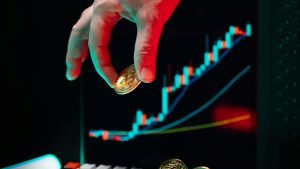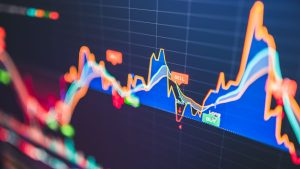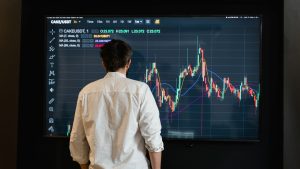If you’ve traded crypto, forex, or futures long enough, you know one truth — volatility exposes emotion.
When markets move fast, so do your thoughts. Fear, greed, hesitation, and overconfidence can hit in seconds. One moment you’re confident; the next, you’re staring at your screen wondering what just happened.
Volatility isn’t the enemy. Emotional reactions are.
The traders who win long-term aren’t the ones who predict every move — they’re the ones who stay calm, disciplined, and structured when everyone else is losing control.
Here’s how to do exactly that. 👇
🧠 Step 1: Understand What Volatility Does to the Brain
When price starts moving rapidly, your body reacts before your logic does.
Your amygdala (fight-or-flight center) activates, releasing cortisol and adrenaline — designed for survival, not trading.
That’s why volatile markets make you:
- Chase impulsive entries (“I’ll miss it if I don’t act now!”)
- Exit early out of fear
- Hold losers too long hoping they’ll “bounce back”
You can’t stop those instincts — but you can control how you respond.
The Fix:
Build awareness. When volatility spikes, your first job isn’t to trade — it’s to recognize your emotional state.
If your heart rate’s up, hands are sweaty, or you’re glued to the screen — step back. You’re not trading the market anymore; you’re reacting to it.
⚙️ Step 2: Build a Plan Before Volatility Hits
Volatile markets reward preparation and punish emotion.
If you don’t have a plan before the candle moves, you’ll end up chasing it.
Your Pre-Volatility Plan Should Include:
- Defined Entry & Exit Rules: Know exactly where you’ll enter and why.
- Stop Loss Placement: Non-negotiable. Protects you from overreaction.
- Position Sizing: Smaller during high volatility — always.
- News Awareness: Major CPI, FOMC, or crypto events can trigger unexpected moves.
You can’t control the market, but you can control your preparation.
💡 Step 3: Use Structure to Stay Grounded
When emotions rise, structure saves you.
Professional traders rely on routines that anchor them to logic when volatility spikes.
Try This:
- Stick to your pre-market checklist no matter what.
- Trade only your top 1–2 setups.
- Limit your daily trades — overtrading is emotional trading.
- Review your journal midweek to track your behavior under stress.
Structure doesn’t stop emotion — it gives it a boundary.
📉 Step 4: Lower Size, Lower Pressure
If volatility scares you, the solution isn’t to quit trading — it’s to lower your size until you can think clearly.
Trading smaller reduces the emotional weight of every tick.
It turns “panic” into “practice.”
Example:
If you normally risk 1% per trade, cut it to 0.25% when volatility spikes.
That small shift buys you clarity, discipline, and control.
You don’t have to be fearless — you just have to be functional under pressure.
🔄 Step 5: Accept That Volatility = Opportunity
Most traders fear volatility. Professionals anticipate it.
Why? Because volatility brings liquidity, momentum, and opportunity — if you can stay calm.
The key isn’t avoiding volatile markets; it’s mastering your reaction to them.
View each move as neutral — not good or bad. The chart doesn’t care about your feelings.
When you stop taking market movement personally, you’ll start seeing volatility for what it really is: a signal, not a threat.
🧘 Step 6: Use Physical Anchors to Reset Emotion
You can’t outthink emotion with logic alone. You have to physically reset.
During high-stress moments:
- Step away from the screen for 3–5 minutes.
- Breathe deeply — 4 seconds in, 4 seconds hold, 4 seconds out.
- Stretch your shoulders and neck (where tension hides).
- Re-enter only when your body calms down.
Your mental clarity depends on your physical calm.
🔍 Step 7: Focus on Execution, Not Equity
When volatility spikes, most traders start staring at their PnL — watching every dollar move like it’s life or death.
That’s how you lose focus.
Shift your attention back to execution metrics, not your account balance.
Ask yourself:
✅ Did I follow my plan?
✅ Did I manage risk?
✅ Did I respect my stop loss?
If the answer is yes, you already won — regardless of the result.
💬 Step 8: Debrief After Every Volatile Session
After a high-volatility session, emotions linger. Don’t just walk away — debrief.
Write down:
- How you felt during big moves
- What you did right
- What triggered emotional decisions
- How you’ll respond better next time
Review this weekly. You’ll build emotional muscle the same way athletes build physical strength — through repetition under controlled stress.
🎯 Final Thoughts
Volatile markets don’t break traders — emotions do.
When the charts go wild, your job isn’t to outsmart the market. It’s to out-control yourself.
Confidence isn’t built by avoiding volatility. It’s built by learning to stay calm inside it.
So slow down. Trust your plan. Let the volatility work for you — not against you.
Because in the end, the traders who master emotion always outlast the ones who chase excitement.
Trade Smarter With EPIQ
At EPIQ Trading Floor, we help traders stay composed and consistent with:
✅ Psychology and emotional control training modules
✅ Live breakdowns of volatile crypto and forex sessions
✅ Risk and journaling templates for high-volatility conditions
✅ A 3-day free trial to start learning before risking capital
👉 Join EPIQ today and learn how to control emotion — not be controlled by it.
Not Financial Advice (NFA): This content is for educational purposes only and not financial advice. Always do your own research and manage your risk responsibly.










Responses